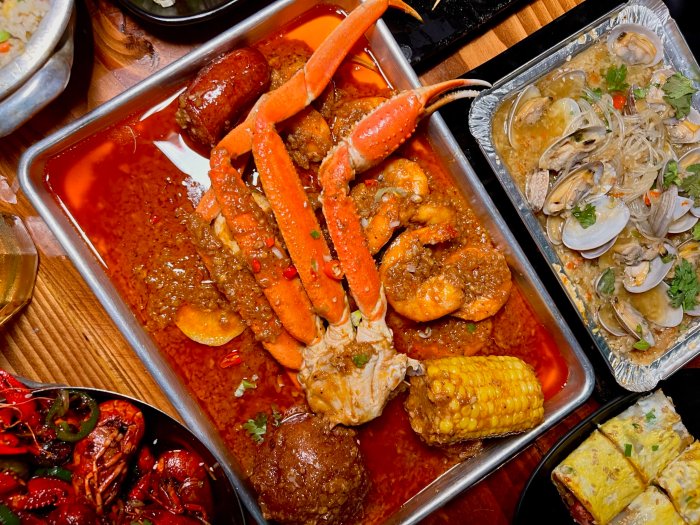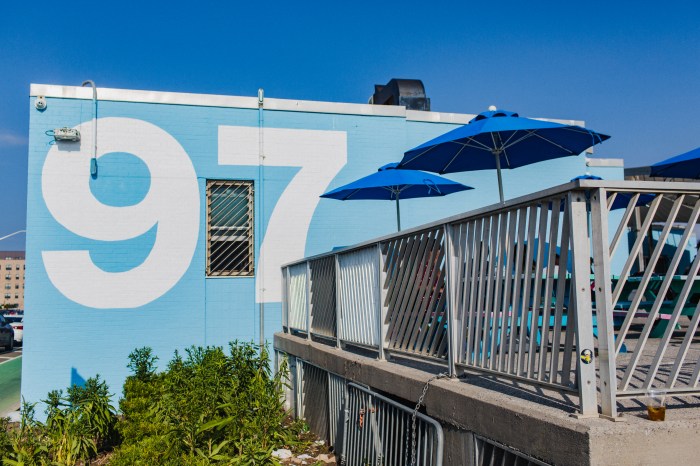By Suzanne Parker
Where but Queens would you see a restaurant touting “Italian ·American · Nepali · Indian Food”? On Broadway in Woodside, just such a sign caught my eye at the Woodside Café Bar and Restaurant. Our curiosity was piqued, only to find out that they’ve thrown in the towel on Italian food while pizza, promoted by a “2 slices and a can of soda for $3” sign in the window is also on its way out. And the word “bar” in the name is a cruel joke, as they don’t serve alcohol. What they do serve is the cuisine of the Newari, an indigenous people of the Katmandu valley of Nepal.
The area where Woodside and Jackson Heights rub shoulders has become something of a little Nepal, with Tibetan-style restaurants popping up like dandelions in spring. But what is offered at Woodside Café differs dramatically from the rather bland fare favored by the Tibetan expats of Nepal. Newari food is seriously spicy, and relies on a great variety of vegetables. The staple of choice is baji, (beaten rice) which tastes like crunchy rice. It is made by taking cooked white rice and pounding it flat and then allowing it to dry. Our server confided that it is favored by Newaris because it has an indefinite shelf life, and is given out for free at the many festivals observed in Nepal. Newaris, also according to our server, are both Hindu and Buddhist, and most recognize the deities of both religions.
The best way to dive into Newari cuisine is to begin with an order of Samay Baji, a tasty sampler of Newari apps. A base of baji supports portions of black-eyed peas, chick peas and roasted soy beans that have a lot in common with Japanese wasabe snacks. Spicy cubes of potatoes in a creamy dressing, equally spicy radish pickle, spinach and a small mound of roasted chicken or beef surround a mini fried lentil cake. The potatoes and pickled radish are a favored condiment with a variety of Newari dishes. They turn up with practically everything.
Lentil cakes called Woh or Bara are ringers for latkes, but with a slight kick. Two large lentil pancakes come with a serving of mutton gravy and a bit of salad.
Newaris have their own take on momo, those meat dumplings so popular in Tibetan restaurants. The version here comes with a choice of chicken or beef mixed with vegetables and spices. They can be had steamed, sautéed, or fried. We took the middle ground with the sautéed, which were served with two piquant sauces. Even though we’ve never met a dumpling we didn’t like, we must say that these were among the tastiest, owing to the unique spicing and to the interesting mix of vegetables in the filling.
A Thali, a popular traditional style of meal presentation throughout the subcontinent, is another good way to snag a sampler of Newari fare. A generous mound of Basmati rice dominates a large platter, surrounded by an assortment of cooked and raw vegetables, spiced kidney beans, and the ubiquitous potato and radish pickles. Bowls of black dal (lentils), your choice of curry (chicken, pork, mutton, fish, or beef), and yogurt accompany. The idea is to mix and match as your fancy takes you. Nepalis seem to eat with a spoon, rather than a fork for this purpose, allowing maximum access to sauces along with the solids. The results are fragrant and satisfying.
Although our server mentioned they are phasing out pizza, he tantalizingly answered that yes, there is such a thing as Newari pizza. That bit of information lured us back to Woodside for a second round of Newari delights.
Newari pizza, we belatedly discovered, isn’t pizza as we think of it. Maybe they’re both round and flat, but that’s about where the similarity ends. In reality it’s a traditional Newari dish called Chatamari, built on a rice flour crepe. A combination of mashed potatoes, black eyed peas, and a choice of meat or veg is spread on the crepe, topped with a fried egg, and served with goat gravy on the side. This may be the winner of all the Café’s offerings. The chatamari was enticingly spiced, cheap and filling. Move over pizza as we know it.
This is a very filling cuisine, but if you still have room for dessert, try Dhau Baji. This is a rice pudding of sorts made by mixing beaten rice with homemade yogurt, unroasted black sesame seeds and sugar. The yogurt gives it tartness and the beaten rice crunch. It’s rather substantial for a dessert, but shared among two or more diners, it’s quite interesting.
The Bottom Line
The decor at Woodside Café borders on the grungy, overlaid with a few Nepalese artifacts. Adherence to their stated hours is lackadaisical. The pacing of the meal can be slow to erratic. With all that being said, Woodside Café offers an opportunity to try a darn tasty cuisine that you won’t find too many other places. If you’re into Food, the Obscure, this is definitely the place for you.
Woodside Café Bar and Restaurant
64-23 Broadway, Woodside, NY
(347) 642-3445
www.woodsidecafe.com
Price Range: Apps: $3.50–$7.95, Mains: $6.95–$11.95
Cuisine: Newmari Nepali
Setting: Old pizzeria decorated with Nepali carvings.
Service: Slow
Hours: Weekdays 11:30 am—11:00 p.m. Fri. & Sat.: 11:30 a.m.—12:00 p.m. Closed Tuesdays.
Reservations: no
Alcohol: No
Parking: Street
Dress: Casual
Children: Welcome
Music: Recorded
Takeout: Yes
Credit cards: Yes
Noise level: Loud recorded Nepali pop music is the norm
Handicap accessible: No
































